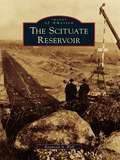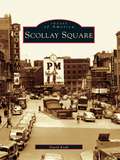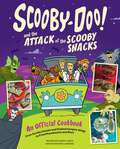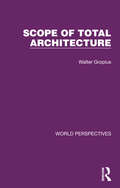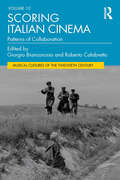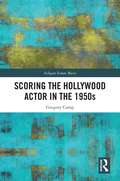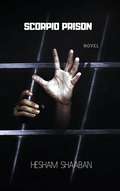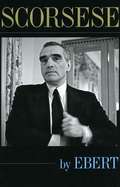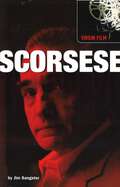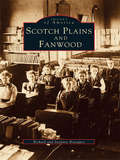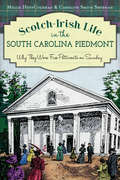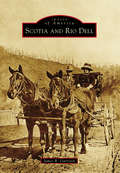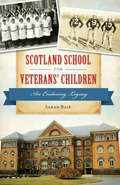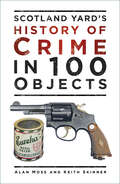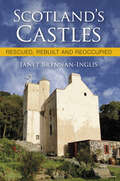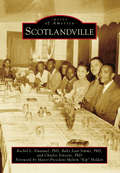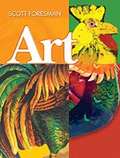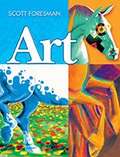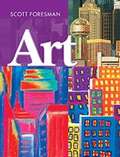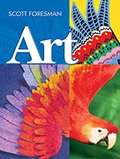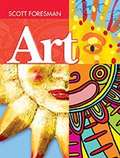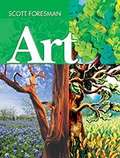- Table View
- List View
Scituate Reservoir, The
by Raymond A. WolfIn 1772, portions of Providence received water through a system of hollowed out logs. By 1869, seventeen years after Zachariah Allen campaigned for a public water supply, the public voted in favor of introducing water into the city from the Pawtuxet River in Cranston. By 1900, it was clear that more, purer water was needed. A public law was approved on April 21, 1915, creating the Providence Water Supply Board and granting the power to condemn 14,800 acres to create the Situate Reservoir. Today the reservoir is the largest inland body of water in Rhode Island, supplying over 40 billion gallons of water to residents.
Scollay Square: Boston's Infamous Scollay Square (Images of America)
by David KruhScollay Square is a pictorial history of the infamous Boston entertainment district that was wiped away by urban renewal in the 1960s. Now Government Center, this twenty-two-acre area was once an entertainment hub where entrepreneurs, scientists, politicians, performers, and even con artists worked side by side. Inside are dozens of never-before-published photographs of the Old Howard and Ann Corio, the Crawford House and Sally Keith, Joe and Nemo, and the Casino Theater, along with the many characters and landmarks that made this area a favorite of high-school truants, businessmen, and sailors on leave.
Scooby-Doo! and the Attack of the Scooby Snacks [An Official Cookbook]: From Scooby Snacks and Pickled Vampire Wings to Fried Moonbeams and More
by Marc Sumerak Elena Pons CraigScooby-Doo, where are you? Join Scooby, Shaggy, Daphne, Fred, and Velma to solve their latest mystery—just how delicious the 55+ recipes included in Scooby-Doo! and the Attack of the Scooby Snacks are!Zoinks! Scooby-Doo! and the Attack of the Scooby Snacks allows Mystery Incorporated fans to finally answer the question, &“Would you do it for a Scooby Snack?&” This family-friendly cookbook&’s recipes takes fans on an immersive journey through the incredible snacks that Scooby, Shaggy, and the rest of the gang encounter during their mystery-solving antics alongside complementary sidebars with party ideas inspired by all the ghouls and frights of Coolsville. Fans will have the courage to face any monster head on as they recreate delicious, easy-to-follow recipes for Scooby Snacks, Shaggy&’s Jaw-Stretcher Special sandwich, Pot Pie Pizza, Fruitmeiers Ice Cream, a Spooky Haunted House Cake, and so much more. 55+ SNACKS: Jinkies! With more than 55 recipes inspired by the meddling kids and ghoulish monsters of Coolsville, there&’s something to delight everyone STUNNING PHOTOGRAPHY: Features beautiful photography of the delicious, fully prepared recipes to help ensure success MENUS FOR EVERY OCCASION: Includes suggested, themed menus featuring recipes for delicious snacks, stuff to go with snacks, really big snacks, drinkable snacks, and sweet snacks FAMILY-FRIENDLY RECIPES: Perfect for kids, adults, and families, this book has easy-to-follow recipes and everyday ingredients, making it ideal for every chef, meal, and occasion OFFICIALLY LICENSED: Created in conjunction with the studio behind Scooby-Doo
Scope of Total Architecture (World Perspectives #5)
by Walter GropiusOriginally published in 1956, this book provides a non-technical analysis of contemporary building by on the of the world’s greatest architects. Published a few years after the end of WW2, it was an inspiring and constructive picture of what kind of living could lie ahead for Western industrial society. This book, the result of many year in the forefront of architectural experiment and achievement by the author, outlines in practical terms the road to improved existence through science, mass production in building and renewed emphasis on the individual.
Scoring Italian Cinema: Patterns of Collaboration (Musical Cultures of the Twentieth Century)
by Giorgio Biancorosso Roberto CalabrettoScoring Italian Cinema: Patterns of Collaboration redefines what it means to write music for the cinema. In eight richly illustrated chapters and a deft introduction, nine leading music and film scholars revisit the great theme of artistic collaboration from a heretofore unexplored angle: the relationship between film directors and composers in the "Long Italian Post-War" (ca. 1945–1975).Spurred by the surfacing of printed and manuscript scores, sketches, drafts, tapes, letters and miscellaneous notes, the authors of Scoring Italian Cinema examine afresh the partnerships between such figures as Federico Fellini and Nino Rota, Michelangelo Antonioni and Giovanni Fusco, Elio Petri and Ennio Morricone, and Dario Argento and Goblin. The volume also brings to light the role of conductors and performers as well as producers and screenwriters in creating the soundtracks of some of the most important films in the history of Italian cinema, including Bitter Rice (Riso Amaro, 1949), La strada (1954) and Salvatore Giuliano (1962). The intrinsically polyvocal nature of the process of completing a score, such as it emerges in the case studies gathered in Scoring Italian Cinema, invites us to rethink of composing for the films as a new kind of expanded, distributed musical practice.Meticulously researched and written in an accessible style, Scoring Italian Cinema will appeal to scholars and practitioners in the fields of music, film and media studies.
Scoring the Hollywood Actor in the 1950s (Ashgate Screen Music Series)
by Gregory CampScoring the Hollywood Actor in the 1950s theorises the connections between film acting and film music using the films of the 1950s as case studies. Closely examining performances of such actors as James Dean, Montgomery Clift, and Marilyn Monroe, and films of directors like Elia Kazan, Douglas Sirk, and Alfred Hitchcock, this volume provides a comprehensive view of how screen performance has been musicalised, including examination of the role of music in relation to the creation of cinematic performances and the perception of an actor’s performance. The book also explores the idea of music as a temporal vector which mirrors the temporal vector of actors’ voices and movements, ultimately demonstrating how acting and music go together to create a forward axis of time in the films of the 1950s. This is a valuable resource for scholars and researchers of musicology, film music and film studies more generally.
Scorpio Prison
by Hesham Shaaban Naziha MerradThe book title: Scorpio Prison, ( a novel ). The author: Heshem Shaaban. First edition: Cairo, 2016. Deposit number: 9178/2016 I.S.B.N: 978-977-493-255-7. Publisher: Shams for publication and information.
Scorsese by Ebert
by Roger EbertRoger Ebert wrote the first film review that director Martin Scorsese ever received -- for 1967's "I Call First" -- when both men were just embarking on their careers. Ebert had never been touched by a movie in quite the same way before, and this experience created a lasting bond that made him one of Scorsese's most appreciative and perceptive commentators. "Scorsese by Ebert" offers the first record of America's most respected film critic's engagement with the works of America's greatest living director. The book chronicles every single feature film in Scorsese's considerable oeuvre, from his aforementioned debut to his 2008 release, the Rolling Stones documentary, "Shine a Light". Here Ebert puts Scorsese's career in illuminating perspective, exploring the different phases of his development and the abiding themes (many of which reflect Scorsese's Catholicism) that give his work such complexity and depth. All of Ebert's incisive reviews of Scorsese's individual films are here, of course, but there is much more. In the course of eleven interviews done over almost forty years, the book includes Scorsese's own insights on both his accomplishments and disappointments. One of these interviews, the single longest ever conducted with Scorsese, appears here for the first time. Ebert has also written and included six new re-considerations of the director's less commented upon films, as well as a substantial introduction that provides a framework for understanding both Scorsese and his profound impact on American cinema. As Scorsese himself notes in his foreword to this volume, history is the only critic that counts, but the dialogue from which its judgments arise begins with the kind of emotionally alert, historically informed, and intellectually honest writing that Ebert has collected here in this, the ideal pairing of filmmaker and critic.
Scorsese: Virgin Film
by Jim SangsterMartin Scorsese’s obsession with sin and redemption, conflict and violence runs through much of his work. This essential guide to Scorsese explores his career from his early student works, including It’s Not Just You, Murray!: through his personal examinations of his Italian American heritage in Mean Streets, Italianamerican and Goodfellas: the extreme violence of Raging Bull, Taxi Driver and Cape Fear: and the religious themes – from a director who originally wanted to be a priest – of The Last Temptation of Christ and Kundun. Including all Scorsese’s films up to Gangs of New York, this is a comprehensive study of the work of this widely respected film maker. Also covering his influences, the controversy surrounding his films, exhaustive music lists and long-time collaborations, this is an extensive analysis of the most consistently passionate, committed and inventive film director of the last thirty years.
Scotch Plains and Fanwood (Images of America)
by Richard Bousquet Suzanne BousquetThis wonderful new book contains more than 200 fascinating photographs, maps, and prints and brings to life the people, places, and events which have defined Scotch Plains and Fanwood over the centuries. These images invite us to explore the area's rich history from the time of its first settlement, in 1684, to the present day. Scotch Plains and Fanwood were originally one community,also encompassing the area now known as Feltville or Glenside Park. From the beginning, the region played a critical role in American history. The Battle of the Short Hills, from June 14 to June 30, 1777, between the British under General Howe and the Revolutionary Army under George Washington, took place here. During the nineteenth century, Scotch Plains became an important stop on the "Swift Sure" stage line between New York and Philadelphia. As New York City burgeoned during the nineteenth century and the railroad arrived in Central New Jersey, Scotch Plains and Fanwood became a bedroom community of the metropolis. Finally, in 1895, Fanwood waschartered independently. Later, Feltville became part of the Union County Park System.
Scotch-Irish Life in the South Carolina Piedmont: Why They Wore Five Petticoats on Sunday
by Millie Huff Coleman Caroline Smith Sherman"Five Petticoats on Sunday" was originally published in 1962. The book was a collection of columns written by Caroline S. Coleman containing stories her grandmother told about the Fairview community and the South Carolina Piedmont. Coleman's granddaughters, Millie Coleman and Caroline Sherman, have expanded the book with recipes, history and genealogical resources for an enthralling look at the lives of Scotch-Irish residents in the area from Reconstruction until the 1900s. Find out why most homes in the area had a Prophet's Room. Sit with the children as they wait for the "second table" during visiting season and learn exactly why they wore five petticoats on Sunday. Sherman and Coleman examine a time and lifestyle far away from today's modern conveniences but complete with warmth of family.
Scotia and Rio Dell
by James R. GarrisonOn the banks of the Eel River, amongst Northern California's towering redwood forests, lie the towns of Scotia and Rio Dell. Their histories inseparably intertwined, these two towns formed a larger community supporting the needs of local settlers and industry. Scotia, constructed by the Pacific Lumber Company in the 1880s, stands as a pristine example of the once-prevalent company town in America. The small farming community of Rio Dell flourished along with its sister city and grew to accommodate the needs of an expanding workforce in Humboldt's redwood lumber industry. Where Scotia was orderly and tightly controlled by Pacific Lumber Co. management, Rio Dell developed a reputation for its remote setting, rowdy lumbermen, and bootlegged whiskey.
Scotland School for Veterans' Children: An Enduring Legacy (Campus History)
by Sarah BairBeginning as a school for Civil War orphans, the Scotland School for Veterans' Children became a unique center for education in the heart of Pennsylvania. The school aimed to develop disciplined, patriotic and productive citizens. As the nation became engulfed in the wars of the twentieth century, the Scotland School became even more vital, with a focus on educating the children and orphans of military veterans. Though it was closed by the state in 2009, memories of the school and its community of alumni remain vibrant. Author Sarah Bair charts the history of a place where thousands of children of our nation’s finest found more than just a school—they found a home.
Scotland Yard's History of Crime in 100 Objects
by Alan Moss Keith SkinnerExplore Britain’s dark criminal history through the fascinating objects that have been hidden away in the Crime Museum at Scotland Yard, a collection that, although world-famous, is so sensitive it is not open to public view. Each object tells its own story: the briefcase with a concealed syringe owned by the notorious Kray twins; the gun Ruth Ellis used to murder her lover David Blakely; a burnt-out computer from the Glasgow airport car bomb; a picture from the property of Dennis Nilsen of the grisly drain that was blocked with human body parts; and the gun that Edward Oxford fired at Queen Victoria that failed to assassinate her. Updated to feature new objects that have entered the collection since 2015, Scotland Yard’s History of Crime in 100 Objects is an absorbing, sometimes shocking and often disturbing journey through criminal history. Peer within to experience a unique insight into the crimes and criminals dealt with by Scotland Yard.
Scotland's Castles: Rescued, Rebuilt and Reoccupied
by Janet Brennan-InglisScotland’s Castles is a beautifully illustrated celebration and account of the renaissance of Scottish castles that has taken place since 1950. Over 100 ruined and derelict buildings – from tiny towers to rambling baronial mansions – have been restored as homes, hotels and holiday lets. These restorations have mainly been carried out by new owners without any connections to the land or the family history of the buildings, which they bought as ruins. Their struggles and triumphs, including interviews and first-person accounts, form the core of the book, set in the context of the enormous social, political and economic changes of the late twentieth century.
Scotland's Railways in the 1980s & 1990s: A Snapshot in Time
by Peter J. Green“A book full of nostalgia for those who thought railways after the end of steam would be an endless stream of lookalike boxes . . . a revelation.” —Rail AdventIn the 1980s and early 1990s, Scotland was an excellent destination for the railway enthusiast.The many locomotive hauled trains running through splendid scenery, together with the surviving railway infrastructure and mechanical signaling, provided many fine photographic opportunities.Peter J. Green’s first railway visit to Scotland was on board the Fair Maid railtour to Perth, behind Flying Scotsman in 1983. The following year, he again traveled to Scotland, this time on the F & W Railtours’ The Skirl o’ the Pipes 4, to Kyle of Lochalsh and Mallaig, his first visit to the Scottish Highlands.Green had previously been traveling abroad for railways, but impressed by what he saw, he decided that he would quickly return to photograph the Scottish railway scene, before it changed too much.This was the start of a series of visits, each for one or two weeks, between 1984 and June 1991, covering the whole country.This book is a photographic record of the locomotives, trains and infrastructure of the railways of Scotland and the landscapes through which the trains ran, as recorded by Green’s various cameras during the period of his visits.“Lots to enjoy, not just the Scottish locomotives themselves, but their trains and the world beyond, which in some cases has changed beyond recognition in the years since these photographs were taken. Highly recommended.” —The Railway Magazine
Scotland, CEMA and the Arts Council, 1919-1967: Background, Politics and Visual Art Policy
by Euan McArthurA case study of the relationship between arts and cultural policy and nationalism, Scotland, CEMA and the Arts Council, 1919-1967: Background, Politics and Visual Art Policy examines the overlooked significance of Scotland in the development of British arts policy and institutions. This study is broadly relevant in an era of political devolution, which continues to pose questions for the constituent nations of Britain and their sense of self- and collective identities. Euan McArthur provides a clear account of the background to and evolution of the Council for the Encouragement of Music and the Arts (CEMA) and the Arts Council of Great Britain (ACGB) in Scotland up to the formation of the Scottish Arts Council (SAC) in 1967. He also presents a study of Scottish visual art policy and activities between 1940 and 1967, assessing the successes and failures of visual art policy in Scotland, including the degree to which it evolved differently from England. This development, leading to the re-naming of the Scottish Committee of the ACGB as the SAC, prepared the way for the expansion of activities that marked the 1970s and after. Based on extensive archival research, this book brings to light previously unavailable material, not covered in existing accounts of CEMA/ACGB.
Scotlandville
by Charles Vincent Rachel L. Emanuel Mayor-President Melvin Holden Ruby Jean SimmsA rural village that was once the entry point for the slave trade and home to a cotton plantation, Scotlandville became the largest majority African American town in Louisiana. Located in the northern part of East Baton Rouge Parish, Scotlandville's history is intricately tied to Southern University and A&M College System, the only historically black university system in the United States. Southern University relocated from New Orleans to the bluff of the Mississippi River on the western edge of Scotlandville in 1914. The story of the university and town is a tale of triumph and struggle in the midst of racism, inequality, and oppression. Presented through the theme of firsts in businesses, churches, schools, residential developments, environmental issues, politics, social organizations, and community service, Images of America: Scotlandville focuses on the people who shaped the community economically, politically, socially, and culturally.
Scott Foresman Art
by Robyn Montana TunerWhat is art? Is it a beautiful painting? Is it a colorful garden? Is it a sparkling item of jewelry? Art is all these things and so much more. Art is everywhere. You can experience art every day. It is also important to understand art.
Scott Foresman Art
by Robyn Montana Turner"A picture is worth a thousand words." You may have heard someone say this. It is a reminder of the power of art. Some art communicates beyond words. Is it any wonder that the meaning of art is hard to explain? Most people agree that:artists make art, their works are called artworks,artworks show ideas and feelings
Scott Foresman Art
by Robyn Montana TurnerThis book integrates classroom instruction, hands-on activities, and literacy-building experiences to turn on the power of art for all students.
Scott Foresman Art (California Edition)
by Rebecca BrooksArt may be anything from a song on the radio to a play performed onstage. The subject of this book is visual art. Painting, sculpture, and drawing are all forms of visual art.
Scott Foresman Art (Grade #3)
by Robyn Montana TurnerWhat is art? People have many answers to this question. Most agree that art is about expression. Artworks can express ideas and feelings in special ways. Artists make artworks. Drawings, paintings, and clay pots are artworks. Quilts, photographs, and baskets are artworks too.
Scott Foresman Art (Grade #5)
by Robyn Montana TurnerWhen you look at the world, use an artist's eye to appreciate what you see. Look for the elements of art, or line, shape, color, value, texture, form, and space, that artists use to create their artworks. Artists also use the principles of design, or balance, pattern, rhythm, unity, variety, emphasis, and proportion. These principles help an artist organize the elements to express ideas and feelings.
Scott Weaver: Toothpick Sculptor (Fountas & Pinnell LLI Red #Level O)
by Katy DuffieldFind out how artist Scott Weaver makes three-dimensional toothpick sculptures.
